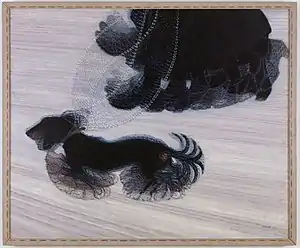The Hand of the Violinist
The Hand of the Violinist (The Rhythms of the Bow) is a 1912 painting by Italian Futurist Giacomo Balla, depicting a musician's hand and the neck of a violin "made to look like it's vibrating through space"—blurred and duplicated to suggest the motion of frenetic playing.[2][3] The painting, representative of Futurism's first wave, exhibits techniques of Divisionism.[4]
| The Hand of the Violinist (The Rhythms of the Bow) | |
|---|---|
.jpg.webp) | |
| Artist | Giacomo Balla |
| Year | 1912 |
| Medium | oil on canvas |
| Subject | The hand of a violinist in play |
| Dimensions | 56 cm × 78.3 cm (22 in × 30.8 in)[1] |
| Location | Estorick Collection of Modern Italian Art, London |
Balla was inspired to use multiplication to imply motion by the photographic experiments of Eadweard Muybridge and Étienne-Jules Marey.[4] As with other Futurists, he was also inspired by Cubism's methods of capturing multiple perspectives; The Hand of the Violinist has been said to bring the viewer "inside the reverberations of the instrument itself", and has earned comparison with Marcel Duchamp's Nude Descending a Staircase.[5]
From February to August 2014, the painting was part of the exhibit Italian Futurism, 1909–1944: Reconstructing the Universe, at the Guggenheim in New York.[4][6]
References
- "The Hand of the Violinist". WikiArt. Retrieved 27 September 2016.
- "Motion pictures: Movement in art and popular culture". The Independent. January 24, 2010. Retrieved 27 September 2016.
- Opam, Kwame (May 1, 2014). "How Futurism transformed the art world by worshipping technology". The Verge. Retrieved 1 November 2016.
- Greenwald, Xico (April 22, 2014). "Back to the Futurism". New York Sun. Retrieved 1 November 2016.
- Bertrand, Sandra (July 24, 2014). "Invasion of the Italian Futurists". Highbrow Magazine. Retrieved 1 November 2016.
- "Italian Futurism, 1909–1944: Reconstructing the Universe". Guggenheim. Retrieved 1 November 2016.
